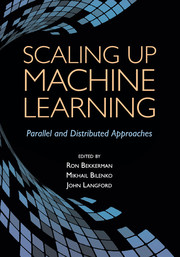Refine search
Actions for selected content:
2327 results in Pattern Recognition and Machine Learning
8 - Direct Density-Ratio Estimation with Dimensionality Reduction
- from Part II - Methods of Density-Ratio Estimation
-
- Book:
- Density Ratio Estimation in Machine Learning
- Published online:
- 05 March 2012
- Print publication:
- 20 February 2012, pp 89-116
-
- Chapter
- Export citation
Contents
-
- Book:
- Density Ratio Estimation in Machine Learning
- Published online:
- 05 March 2012
- Print publication:
- 20 February 2012, pp v-viii
-
- Chapter
- Export citation
Foreword
-
-
- Book:
- Density Ratio Estimation in Machine Learning
- Published online:
- 05 March 2012
- Print publication:
- 20 February 2012, pp ix-x
-
- Chapter
- Export citation
6 - Density-Ratio Fitting
- from Part II - Methods of Density-Ratio Estimation
-
- Book:
- Density Ratio Estimation in Machine Learning
- Published online:
- 05 March 2012
- Print publication:
- 20 February 2012, pp 67-74
-
- Chapter
- Export citation
Part II - Methods of Density-Ratio Estimation
-
- Book:
- Density Ratio Estimation in Machine Learning
- Published online:
- 05 March 2012
- Print publication:
- 20 February 2012, pp 21-24
-
- Chapter
- Export citation
12 - Conditional Probability Estimation
- from Part III - Applications of Density Ratios in Machine Learning
-
- Book:
- Density Ratio Estimation in Machine Learning
- Published online:
- 05 March 2012
- Print publication:
- 20 February 2012, pp 191-212
-
- Chapter
- Export citation
5 - Density Fitting
- from Part II - Methods of Density-Ratio Estimation
-
- Book:
- Density Ratio Estimation in Machine Learning
- Published online:
- 05 March 2012
- Print publication:
- 20 February 2012, pp 56-66
-
- Chapter
- Export citation
List of Symbols and Abbreviations
-
- Book:
- Density Ratio Estimation in Machine Learning
- Published online:
- 05 March 2012
- Print publication:
- 20 February 2012, pp 307-308
-
- Chapter
- Export citation
Frontmatter
-
- Book:
- Density Ratio Estimation in Machine Learning
- Published online:
- 05 March 2012
- Print publication:
- 20 February 2012, pp i-iv
-
- Chapter
- Export citation
16 - Non-Parametric Numerical Stability Analysis
- from Part IV - Theoretical Analysis of Density-Ratio Estimation
-
- Book:
- Density Ratio Estimation in Machine Learning
- Published online:
- 05 March 2012
- Print publication:
- 20 February 2012, pp 275-300
-
- Chapter
- Export citation
7 - Unified Framework
- from Part II - Methods of Density-Ratio Estimation
-
- Book:
- Density Ratio Estimation in Machine Learning
- Published online:
- 05 March 2012
- Print publication:
- 20 February 2012, pp 75-88
-
- Chapter
- Export citation
Preface
-
- Book:
- Density Ratio Estimation in Machine Learning
- Published online:
- 05 March 2012
- Print publication:
- 20 February 2012, pp xi-xii
-
- Chapter
- Export citation
4 - Probabilistic Classification
- from Part II - Methods of Density-Ratio Estimation
-
- Book:
- Density Ratio Estimation in Machine Learning
- Published online:
- 05 March 2012
- Print publication:
- 20 February 2012, pp 47-55
-
- Chapter
- Export citation
Part I - Density-Ratio Approach to Machine Learning
-
- Book:
- Density Ratio Estimation in Machine Learning
- Published online:
- 05 March 2012
- Print publication:
- 20 February 2012, pp 1-2
-
- Chapter
- Export citation
17 - Conclusions and Future Directions
- from Part V - Conclusions
-
- Book:
- Density Ratio Estimation in Machine Learning
- Published online:
- 05 March 2012
- Print publication:
- 20 February 2012, pp 303-306
-
- Chapter
- Export citation
Bibliography
-
- Book:
- Density Ratio Estimation in Machine Learning
- Published online:
- 05 March 2012
- Print publication:
- 20 February 2012, pp 309-326
-
- Chapter
- Export citation
14 - Non-Parametric Convergence Analysis
- from Part IV - Theoretical Analysis of Density-Ratio Estimation
-
- Book:
- Density Ratio Estimation in Machine Learning
- Published online:
- 05 March 2012
- Print publication:
- 20 February 2012, pp 236-251
-
- Chapter
- Export citation

Scaling up Machine Learning
- Parallel and Distributed Approaches
-
- Published online:
- 05 February 2012
- Print publication:
- 30 December 2011
Frontmatter
-
- Book:
- Bayesian Reasoning and Machine Learning
- Published online:
- 05 June 2012
- Print publication:
- 02 February 2012, pp i-iv
-
- Chapter
- Export citation
12 - Bayesian model selection
- from II - Learning in probabilistic models
-
- Book:
- Bayesian Reasoning and Machine Learning
- Published online:
- 05 June 2012
- Print publication:
- 02 February 2012, pp 284-302
-
- Chapter
- Export citation
